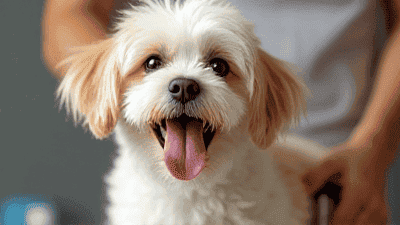
Grooming is an essential part of pet care, but for many pets (and their owners), it can be a stressful experience. Whether it’s brushing, bathing, nail trimming, or ear cleaning, grooming is often met with resistance, anxiety, or even fear from our furry friends. However, with the right training and techniques, you can help your pet stay calm and cooperative during grooming sessions.
Regular grooming helps maintain your pet’s overall health by:
Grooming can strengthen the bond between you and your pet when done in a calm and positive manner. It’s a chance to show your pet love and care while meeting their physical needs.

Many pets associate grooming with negative experiences, such as discomfort or restraint. This can lead to fear and anxiety during grooming sessions.
Some pets are naturally sensitive to being touched in certain areas, such as their paws, ears, or tail.
Pets who are not accustomed to grooming tools or routines may feel overwhelmed or confused.
Introduce grooming to your pet as early as possible, especially during their puppy or kitten stage. Early exposure helps them become accustomed to the process.
Choose a quiet, comfortable space for grooming where your pet feels safe. Avoid loud noises or distractions that could increase their anxiety.
Use appropriate grooming tools for your pet’s size, coat type, and specific needs. For example:

Desensitization involves gradually introducing your pet to grooming tools and procedures in a positive and non-threatening way. Here’s how:
Use positive reinforcement to create a positive association with grooming. Reward your pet with treats, praise, or playtime after each step of the grooming process. This helps them understand that grooming leads to good things.
Keep grooming sessions short, especially in the beginning. Gradually increase the duration as your pet becomes more comfortable. This prevents overwhelming your pet.
Teach your pet to tolerate being touched in sensitive areas by practicing gentle handling. For example:
Your pet can pick up on your energy, so stay calm and relaxed during grooming. Speak in a soothing voice and avoid sudden movements.

If your pet resists grooming, take a break and try again later. Gradually build their tolerance by breaking the process into smaller steps.
If your pet is afraid of a particular tool, such as clippers or a blow dryer, desensitize them by introducing the tool slowly and pairing it with treats and praise.
For pets with severe anxiety or aggression, consult a professional trainer or behaviorist. They can help address underlying issues and create a customized training plan.
If your pet has a thick, matted coat or requires specialized grooming techniques, consider seeking help from a professional groomer.
For pets with severe anxiety, aggression, or fear of grooming, consult a veterinarian or animal behaviorist. They can provide guidance and, if necessary, recommend calming aids or medications.
Training your pet to be calm during grooming is a process that requires patience, consistency, and positive reinforcement. By creating a calm environment, introducing grooming gradually, and rewarding good behavior, you can transform grooming from a stressful chore into a bonding experience. Remember to tailor your approach to your pet’s unique needs and personality, and don’t hesitate to seek professional help if needed. With time and practice, your pet will learn to associate grooming with comfort and care, making it a positive routine for both of you.